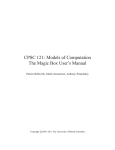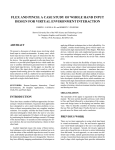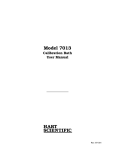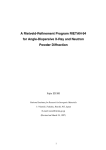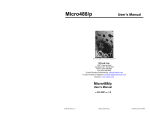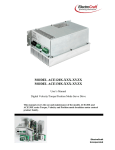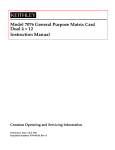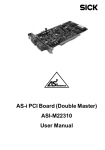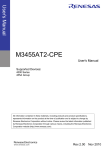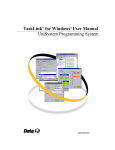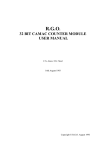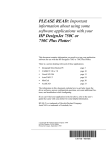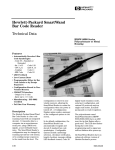Download Serial488A, OEM, and 512K
Transcript
Serial488A, Serial488A/OEM, Serial488A/512K User’s Manual IOtech, Inc. 25971 Cannon Road Cleveland, OH 44146 Phone: (440) 439-4091 Fax: (440) 439-4093 E-mail: [email protected] Internet: http://www.iotech.com Serial488A, Serial488A/OEM, Serial488/512K User’s Manual p/n SERIAL488/A-901, Rev 2.3 © 1998 by IOtech, Inc. — Printed in the United States of America Warranty Your IOtech warranty is as stated on the product warranty card. You may contact IOtech by phone, fax machine, or e-mail in regard to warranty-related issues. Phone: (440) 439-4091, fax: (440) 439-4093, email: [email protected] Limitation of Liability IOtech, Inc. cannot be held liable for any damages resulting from the use or misuse of this product. Copyright, Trademark, and Licensing Notice All IOtech documentation, software, and hardware are copyright with all rights reserved. No part of this product may be copied, reproduced or transmitted by any mechanical, photographic, electronic, or other method without IOtech’s prior written consent. IOtech product names are trademarked; other product names, as applicable, are trademarks of their respective holders. All supplied IOtech software (including miscellaneous support files, drivers, and sample programs) may only be used on one installation. You may make archival backup copies. FCC Statement IOtech devices emit radio frequency energy in levels compliant with Federal Communications Commission rules (Part 15) for Class A devices. If necessary, refer to the FCC booklet How To Identify and Resolve Radio-TV Interference Problems (stock # 004-000-00345-4) which is available from the U.S. Government Printing Office, Washington, D.C. 20402. CE Notice Many IOtech products carry the CE marker indicating they comply with the safety and emissions standards of the European Community. As applicable, we ship these products with a Declaration of Conformity stating which specifications and operating conditions apply. Warnings and Cautions Refer all service to qualified personnel. This caution symbol warns of possible personal injury or equipment damage under noted conditions. Follow all safety standards of professional practice and the recommendations in this manual. Using this equipment in ways other than described in this manual can present serious safety hazards or cause equipment damage. This warning symbol is used in this manual or on the equipment to warn of possible injury or death from electrical shock under noted conditions. This ESD caution symbol urges proper handling of equipment or components sensitive to damage from electrostatic discharge. Proper handling guidelines include the use of grounded anti-static mats and wrist straps, ESD-protective bags and cartons, and related procedures. Specifications and Calibration Specifications are subject to change without notice. Significant changes will be addressed in an addendum or revision to the manual. As applicable, IOtech calibrates its hardware products to published specifications. Periodic hardware calibration is not covered under the warranty and must be performed by qualified personnel as specified in this manual. Improper calibration procedures may void the warranty. Quality Notice IOtech has maintained ISO 9001 certification since 1996. Prior to shipment, we thoroughly test our products and review our documentation to assure the highest quality in all aspects. In a spirit of continuous improvement, IOtech welcomes your suggestions. Introduction 1.1 Description The Serial488A, Serial488A/OEM and Serial488/512K Bus Converters provide transparent communication from a serial computer to an IEEE 488 printer, plotter or other device. They also can be used to control a serial device, such as a printer or terminal, from an IEEE 488 host computer. As a serial to IEEE 488 converter, it receives data from a serial host then automatically performs the bus sequences necessary to send this data to the IEEE 488 device. If desired, data can be requested from the IEEE 488 device and returned to the host. As an IEEE 488 to serial converter, it functions as a peripheral to an IEEE 488 controller. Data received from the controller is sent to the serial device, and data received from the serial device is buffered for transmission to the IEEE 488 controller. The converter can inform the host, by the serial poll status byte, that it has received data from the serial device. The Serial488A and Serial488A/OEM can communicate with RS-232 and RS422 devices by positioning configuration jumpers located within the unit. Both devices can communicate at selectable baud rates up to 57600 baud. The Serial488/512K can communicate with RS-232 devices at selectable baud rates up to 19200 baud. This manual will refer to all three interfaces as the Serial488A. Differences between the Serial488A, Serial488A/OEM and Serial488/512K will be noted where applicable. 1.1 1.2 Serial488 and Serial488A Differences The Serial488A is both a hardware and firmware upgrade to the Serial488. When issuing product improvements, we try to maintain transparent compatibility. Occasionally this is not possible. You should note the following differences between the two products. 1. The Serial488 allocated fixed serial and IEEE input buffers of 4000 characters. The Serial488A utilizes a 32,000 character buffer which is dynamically allocated to the serial and IEEE input buffers as required. Refer to Section 4.2 for more details 2. The Serial488A has the ability to output RS-232 or RS-422 levels. The levels used are internally selectable. Refer to Section 2.8 for details. 3. As a peripheral, the Serial488A's serial poll status byte has been changed to include status of the serial handshake. Other minor changes have also been included. Refer to Section 4.4 for a complete description of the serial poll status byte. 4. The internal switch settings for baud rate have been adjusted to include 57600 baud. Refer to Section 2.3 for the new switch settings. 1.3 Serial488A, Serial488A/OEM and Serial488/512K Differences 1. The Serial488A and Serial488A/OEM utilize a 32,000 character buffer which is dynamically allocated to the serial and IEEE input buffers as required. The Serial488/512K utilizes a 512,000 character buffer which is dynamically allocated to the serial and IEEE input buffers as required. 2. The Serial488A and Serial488A/OEM have the ability to output RS-232 or RS-422 levels. The Serial488/512K can only operate at RS-232 levels. 3. The Serial488A and Serial488A/OEM can operate at selectable baud rates up to 57600 baud. The Serial488/512K can operate at selectable baud rates up to 19200 baud. 1.2 1.4 Available Accessories Additional accessories that can be ordered for the Serial488A include: CA-7-1 CA-7-2 CA-7-3 CA-7-4 CA-11 CA-21 CA-22 CA-23 CN-20 CN-22 CN-23 ABC488 Rack488-3 Rack488-4 140-0920 1.5 foot IEEE 488 Cable 6 foot IEEE 488 Cable 6 foot shielded IEEE 488 Cable 6 foot reverse entry IEEE 488 Cable 12 foot IBM PC/XT/PS2 to Serial488A RS-232 Cable 12 foot Macintosh II/SE/Plus to Serial488A RS-232 Cable 12 foot Macintosh 512K to Serial488A RS-232 Cable 12 foot IBM AT to Serial488A RS-232 Cable Right Angle IEEE 488 adapter, male and female IEEE 488 Multi-tap bus strip, four female connectors in parallel IEEE 488 panel mount feed-through connector, male and female IEEE 488 ABC switch 5-1/4" by 19" rack mount for one Serial488A 5-1/4" by 19" rack mount for two Serial488As Instruction Manual 1.3 Specifications :$51,1* Do not use this interface outdoors! The interface is intended for indoor use only! Outdoor conditions could result in equipment failure, bodily injury or death! :$51,1* If equipment is used in any manner not specified in this manual, the protection provided by the equipment may be impaired. Please read this manual carefully. &$87,21 Do not connect AC line power directly to the Serial488A. Direct AC connection will damage the equipment. Serial488A IEEE 488 &$87,21 The IEEE 488 terminal must only be used to control a non-isolated IEEE 488 system. The common mode voltage (cable shell to earth) must be zero. Terminal Installation Category: Standard: Not Applicable CE: Category 1 Implementation: C1, C2, C3, C4 and C28 controller subsets.(Serial to IEEE) SH1, AH1, T6, TE0, L4, LE0, SR1, RL0, PP0, DC1, DT0, E1. Terminators: Selectable CR, LF, LF-CR and CR-LF with EOI. Connector: Standard IEEE 488 connector with metric studs. Serial Interface Terminal Installation Category: Standard: Not Applicable CE: Category 1 EIA RS-232C: AB, BA, BB, CA, CB EIA RS-422A: Balanced voltage on TxD and RxD. Character Set: Asynchronous bit serial. Output Voltage: ±5 volts min (RS-422A). 5 volts typical (RS-232C). Input Voltage: ±3 volts min.; ±15v max. Baud Rate: Selectable 110, 300, 600, 1200, 1800, 2400, 3600, 4800, 7200, 9600, 19,200 and 57,600. 1.4 Data Format: Duplex: Serial Control: Terminators: Connector: Selectable 7 or 8 data bits; 1 or 2 stop bits; odd, even, mark, space and no parity on transmit. Full with Echo/No Echo. Selectable CTS/RTS or XON/XOFF. Selectable CR, LF, LF-CR and CR-LF. 25-pin Sub-D male. DCE Configured. General Terminal Installation Category: Data Buffer: Indicators: Power: Dimensions: Weight: Standard: Not Applicable CE: Category 1 for all terminals. 32,000 characters dynamically allocated. LEDs for IEEE Talk and Listen, Serial Send and Receive, and Power. An external power supply is provided with the Serial488A. Input is 105 to 125VAC; 50 to 60 Hz, 10 VA Maximum. 188mm deep x 140mm wide x 68mm high (7.39" x 5.5" x 2.68"). 1.55 kg. (3.6 lbs). Operating Environment: Standard: Indoor use, 0° to 50°C; 0 to 70% R.H. to 35°C. Linearly derate 3% R.H./°C from 35° to 50°C. CE: Indoor use at altitudes below 2000m, 0° to 40°C; 80% maximum RH up to 31°C decreasing linearly 4% RH/°C to 40°C. Controls: Power Switch (external), IEEE and Serial parameter switches (internal). Jumper selection of RS-232 or RS-422 operation (internal). *Specifications subject to change without notice. 1.5 Serial488A/OEM IEEE 488 Implementation: Terminators: Connector: Serial Interface EIA RS-232C: EIA RS-422A: Character Set: Output Voltage: Input Voltage: Baud Rate: Data Format: Duplex: Serial Control: Terminators: Connector: General Data Buffer: Indicators: Power: Dimensions: Weight: Environment: Controls: C1, C2, C3, C4 and C28 controller subsets.(Serial to IEEE) SH1, AH1, T6, TE0, L4, LE0, SR1, RL0, PP0, DC1, DT0, E1. Selectable CR, LF, LF-CR and CR-LF with EOI. Standard IEEE 488 connector with metric studs. AB, BA, BB, CA, CB Balanced voltage on TxD and RxD. Asynchronous bit serial. ±5 volts min (RS-422A). 5 volts typical (RS-232C). ±3 volts min.; ±15v max. Selectable 110, 300, 600, 1200, 1800, 2400, 3600, 4800, 7200, 9600, 19,200 and 57,600. Selectable 7 or 8 data bits; 1 or 2 stop bits; odd, even, mark, space and no parity on transmit. Full with Echo/No Echo. Selectable CTS/RTS or XON/XOFF. Selectable CR, LF, LF-CR and CR-LF. 25-pin Sub-D male. DCE Configured. 32,000 characters dynamically allocated. LEDs for IEEE Talk and Listen, Serial Send and Receive, and Power. User supplied +5 volts ±0.25% at 1 amp. Mating power connector with 8 inch leads provided. 205mm deep x 115mm wide x 28mm high (8" x 4.5" x 1.1"). 0.23kg. (0.5 lbs.) 0° - 50°C; 0 to 70% R.H. to 35°C. Linearly derate 3% R.H./°C from 35° to 50°C. IEEE and Serial parameter switches. Jumper selection of RS-232 or RS-422 operation. *Specifications subject to change without notice. 1.6 Serial488/512K IEEE 488-1978 Implementation: Terminators: Connector: Serial Interface. EIA RS-232C: Character Set: Output Voltage: Input Voltage: Baud Rate: Data Format: Duplex: Serial Control: Terminators: Connector: General Data Buffer: Indicators: Power: Dimensions: Weight: Environment: Controls: C1, C2, C3, C4 and C28 controller subsets.(Serial to IEEE) SH1, AH1, T6, TE0, L4, LE0, SR1, RL0, PP0, DC1, DT0, E1. Selectable CR, LF, LF-CR and CR-LF with EOI. Standard IEEE 488 connector with metric studs. AB, BA, BB, CA, CB Asynchronous bit serial. 5 volts typical (RS-232C). ±3 volts min.; ±15v max. Selectable 110, 300, 600, 1200, 1800, 2400, 3600, 4800, 7200, 9600, and 19,200. Selectable 7 or 8 data bits; 1 or 2 stop bits; odd, even, mark, space and no parity on transmit. Full with Echo/No Echo. Selectable CTS/RTS or XON/XOFF. Selectable CR, LF, LF-CR and CR-LF. 25-pin Sub-D male. DCE Configured. 512,000 characters. LEDs for IEEE Talk and Listen, Serial Send and Receive, and Power. 105-125V or 210-250V; 50-60 Hz, 10 VA Max. 188mm deep x 140mm wide x 68mm high (7.39" x 5.5" x 2.68"). 1.95 kg. (4.35 lbs). 0° - 50°C; 0 to 70% R.H. to 35°C. Linearly derate 3% R.H./°C from 35° to 50°C. Power Switch (external) IEEE and Serial parameter switches (internal). *Specifications subject to change without notice. 1.7 1.6 Abbreviations The following IEEE 488 abbreviations are used throughout this manual. addr n ATN CA CO CR data DCL GET GTL LA LAG LF LLO MLA MTA PE PPC PPU SC SDC SPD SPE SRQ TA TAD TCT term UNL UNT * IEEE bus address "n" Attention line Controller Active Controller Carriage Return Data String Device Clear Group Execute Trigger Go To Local Listener Active Listen Address Group Line Feed Local Lock Out My Listen Address My Talk Address Peripheral Parallel Poll Configure Parallel Poll Unconfigure System Controller Selected Device Clear Serial Poll Disable Serial Poll Enable Service Request Talker Active Talker Address Take Control Terminator Unlisten Untalk Unasserted 1.8 Getting Started 2.1 Inspection The Serial488A was carefully inspected, both mechanically and electrically, prior to shipment. When you receive the interface, carefully unpack all items from the shipping carton and check for any obvious signs of physical damage which may have occurred during shipment. Immediately report any such damage found to the shipping agent. Remember to retain all shipping materials in the event that shipment back to the factory becomes necessary. Every Serial488A is shipped with the following.... • Serial488A • 140-0920 • Power Supply IEEE 488 Bus Converter Instruction Manual 9 Volt Regulated TR-2; 115V or TR-2E; 220V Every Serial488A/OEM is shipped with the following.... • Serial488A/OEM • 140-0920 IEEE 488 Bus Converter Instruction Manual Every Serial488/512K is shipped with the following.... • Serial488/512K • 140-0920 • Power Supply IEEE 488 Bus Converter Instruction Manual 9 Volt Regulated TR-2; 115V or TR-2E; 220V 2.1 2.2 Configuration Three DIP switches internal to the Serial488A set the configuration of the interface. NOTE: Selectable functions are read ONLY at power-on and should only be set prior to applying power to the interface. The following figures illustrate the factory default settings which are: Serial Port: 9600 Baud 8 Data Bits 2 Stop Bits No Parity Serial Terminator = LF Echo Disabled RTS/CTS Handshake IEEE: Mode = IEEE 488 Controller Address = 10 Bus Terminator = LF; EOI Disabled Talk-back on Terminator Enabled Talk-back on Time Out Enabled SW3 Factory Default Settings SW3 1 2 3 4 5 6 7 8 OPEN IEEE Addr 10 IEEE Term LF EOI Disabled 2.2 Switch Side View DOT SW2 Factory Default Settings SW2 1 2 3 4 5 6 7 8 Switch Side View DOT OPEN Mode C Talk Back on Time Out Enabled LF Serial Term Echo No Echo Parity No Parity SW1 Factory Default Settings SW1 1 2 3 4 5 6 7 8 Switch Side View DOT OPEN Baud Rate Handshake Word Length Talk Back on Term Stop Bits 9600 RTS/CTS 8 Data Bits Enabled 2 Stop Bits The following drawings show the locations of switches SW1, SW2, and SW3 for the Serial488A, Serial488A/OEM and the Serial488/512K. The top circuit board in the Serial488A and the Serial488/512K is referred to as the I/O board. 2.3 Serial488A Switch Location - I/O Board S203 SW3 S202 SW2 OPEN SW3 SW2 S201 SW1 1 2 3 4 5 6 7 8 SW1 1 2 3 4 5 6 7 8 OPEN 1 2 3 4 5 6 7 8 OPEN Serial488A/OEM Switch Location S101 1 2 3 4 5 6 7 8 SW1 OPEN SW-6-8 S102 1 2 3 4 5 6 7 8 SW2 OPEN SW-6-8 S103 1 2 3 4 5 6 7 8 SW3 OPEN SW-6-8 2.4 Serial488/512K SW1, SW2 Location - I/O Board 1 2 3 4 5 6 7 8 SW2 OPEN C-5-.1 SW-6-8 74HCT244 IC-39 RN-1-10K 1 2 3 4 5 6 7 8 SW1 OPEN SW-6-8 Serial488/512K SW3 Location - Motherboard 1 2 3 4 5 6 7 8 OPEN S102 2.5 SW3 Note that the Serial488A comes configured as an IEEE controller. In this mode the Serial488A is designed to allow an RS-232 computer to communicate with an IEEE peripheral such as a plotter. This controller mode is described in detail in Section 3. The Serial488A may also be configured as an IEEE peripheral. As an IEEE peripheral, the Serial488A allows an IEEE controller to communicate with an RS-232 device. The peripheral mode of operation is described in detail in Section 4. To modify any of these defaults, follow this simple procedure: Disconnect the power supply from the AC line and from the interface. Disconnect any IEEE or serial cables prior to disassembly. WARNING Never open the Serial488A case while it is connected to the AC line. Failure to observe this warning may result in equipment failure, personal injury or death. Place the interface upside down on a flat surface. Remove the four (4) screws located near the rubber feet. Return the interface to the upright position and carefully remove the top cover. Modify those parameters which are appropriate for your installation and then carefully re-assemble the interface using the reverse of the procedure described. 2.3 Serial Port Settings The first parameters to configure are those that correspond to the RS-232 port. These include baud rate, word length, number of stop bits, parity selection and type of RS-232 handshake. Each of these are described in the following sections. 2.3.1 Serial Baud Rate Selection Baud rate defines the number of serial bits per second transferred into and out of the RS-232 interface. SW1-1 through SW1-4 determine the serial baud rate. The factory default baud rate is 9600 baud. Baud rates may be selected from 110 to 57600 baud (110 to 19200 for the Serial488/512K). 2.6 Refer to the following diagram for specific baud rates. Note: on the Serial488/512K, selecting 57600 baud will have the same effect as selecting 19200 baud. SW1 View for Serial Baud Rate Selection 1 2 3 4 5 6 7 8 110 1 2 3 4 5 6 7 8 1800 OPEN OPEN 1 2 3 4 5 6 7 8 1 2 3 4 5 6 7 8 110 2400 OPEN OPEN 1 2 3 4 5 6 7 8 1 2 3 4 5 6 7 8 110 3600 OPEN OPEN 1 2 3 4 5 6 7 8 1 2 3 4 5 6 7 8 135 4800 OPEN OPEN 1 2 3 4 5 6 7 8 1 2 3 4 5 6 7 8 150 7200 OPEN OPEN 1 2 3 4 5 6 7 8 1 2 3 4 5 6 7 8 300 9600 OPEN OPEN 1 2 3 4 5 6 7 8 1 2 3 4 5 6 7 8 600 19200 OPEN OPEN 1 2 3 4 5 6 7 8 1 2 3 4 5 6 7 8 1200 57600 OPEN OPEN 2.7 Switch Side View DOT 2.3.2 Serial Word Length Selection - Data Bits SW1-6 determines the number of data bits, often referred to as word length, for each serial character transmitted or received. The factory default is 8 data bits. SW1 View of Serial Word Length (Data Bits) Selection 1 2 3 4 5 6 7 8 1 2 3 4 5 6 7 8 OPEN Switch Side View DOT OPEN 8 Data Bits 7 Data Bits 2.3.3 Serial Stop Bit Selection Switch SW1-8 determines the number of stop bits contained in each serial character transmitted and received. The factory default is 2 stop bits. SW1 View for Serial Stop Bit Selection 1 2 3 4 5 6 7 8 1 2 3 4 5 6 7 8 OPEN OPEN 1 Stop Bit Switch Side View DOT 2 Stop Bits 2.3.4 Serial Parity Selection Serial Parity is selected with S2-6 through S2-8. The Serial488A generates the selected parity during serial transmissions but it does not check parity on data that is received. The factory default is parity disabled. 2.8 SW2 View for Serial Parity Selection 1 2 3 4 5 6 7 8 1 2 3 4 5 6 7 8 OPEN Switch Side View DOT OPEN Odd Parity Mark Parity 1 2 3 4 5 6 7 8 1 2 3 4 5 6 7 8 OPEN OPEN Even Parity Space Parity 1 2 3 4 5 6 7 8 OPEN Parity Disabled 2.3.5 Serial Echo Selection Serial data sent to the Serial488A will be echoed back to the serial host if SW2-5 is set to the open position. Factory default is Echo Disabled. SW2 View for Echo Selection 1 2 3 4 5 6 7 8 1 2 3 4 5 6 7 8 OPEN Echo Disabled OPEN Echo Enabled 2.9 Switch Side View DOT 2.3.6 Serial Handshake Selection Switch SW1-5 is used to select between hardware [RTS/CTS] or software [Xon/Xoff] serial handshake control. With Xon/Xoff, the Serial488A issues an Xoff character [ASCII value of $13] when its buffer memory is near full. When issued, there is greater than 1000 character locations remaining to protect against buffer overrun. When it is able to accept more information it issues an Xon character [ASCII value of $11]. The Serial488A also accepts Xon/Xoff on transmit from the serial host it is communicating with. RTS/CTS serial control becomes inactive when Xon/Xoff is enabled. The RTS output is, however, set to an active high state. The CTS input is not used for this handshake and may be left floating (unconnected). With RTS/CTS, the Serial488A un-asserts RTS (low) when its buffer memory is near full. When un-asserted, there is greater than 1000 character locations remaining to protect against buffer overrun. When it is able to accept more information it asserts (high) RTS. The Serial488A will not transmit data to the serial host if it detects the CTS input un-asserted (low) when configured for this hardware handshake. The factory default serial control is hardware, RTS/CTS. SW1 View for Serial Handshake Selection 1 2 3 4 5 6 7 8 1 2 3 4 5 6 7 8 OPEN OPEN RTS/CTS Xon/Xoff 2.10 Switch Side View DOT 2.4 Terminator Selection The Serial488A can be configured to provide RS-232 to IEEE 488 and IEEE 488 to RS-232 terminator substitution. This is useful when interfacing an RS-232 device which only issues carriage return [CR] as an output terminator to an IEEE controller which expects a carriage return followed by a line feed [CR-LF]. In the above example, the serial terminator should be selected for CR Only while the IEEE terminator is set to CR-LF. When a serial CR character is received, it is discarded and substituted with an IEEE CR-LF. In the IEEE to RS-232 direction, the IEEE CR is unconditionally discarded. Upon receipt of the IEEE LF, a serial CR is substituted. The Serial488A can be made totally data transparent by setting both the serial and IEEE terminators to be CR Only or LF Only. 2.4.1 Serial Terminator Selection SW2-3 and SW2-4 select the serial terminators for the serial input and output. The factory default is LF Only. SW2 View for Serial Terminator Selection 1 2 3 4 5 6 7 8 1 2 3 4 5 6 7 8 OPEN OPEN CR Only LF-CR 1 2 3 4 5 6 7 8 1 2 3 4 5 6 7 8 OPEN OPEN LF Only CR-LF 2.11 Switch Side View DOT 2.4.2 IEEE Bus Terminator Selection SW3-6 through SW3-8 set the IEEE bus terminators used for data sent or received by the Serial488A. EOI, a line used to signal the end of a multiple character bus transfer, may also be enabled. If enabled, EOI is asserted when the last selected bus terminator is sent. Factory default is LF Only with EOI disabled. SW3 View for IEEE Bus Terminator Selection 1 2 3 4 5 6 7 8 1 2 3 4 5 6 7 8 OPEN OPEN CR Only 1 2 3 4 5 6 7 8 1 2 3 4 5 6 7 8 OPEN OPEN CR-LF 1 2 3 4 5 6 7 8 OPEN EOI Disabled DOT LF-CR LF Only 1 2 3 4 5 6 7 8 Switch Side View OPEN EOI Enabled 2.5 Mode Selection SW2-1 sets the major operating mode of the Serial488A. The IEEE Controller (RS-232 to IEEE Converter) mode allows a serial host device to send data to a single IEEE bus peripheral. Applications include interfacing a listen-only or addressable IEEE printer/plotter to a serial printer port. Refer to Section 3 for more detailed information on the controller mode of operation. 2.12 The Peripheral mode is used when interfacing a serial device to an IEEE controller. Data which is sent by the IEEE controller to the Serial488A is transmitted out its serial port. Data received from the serial device is buffered by the Serial488A until read by the IEEE controller. Refer to Section 4 for more detailed information on the peripheral mode of operation. The factory default is the IEEE Controller mode, an RS-232 to IEEE converter. SW2 View for Mode Selection 1 2 3 4 5 6 7 8 1 2 3 4 5 6 7 8 OPEN OPEN Controller Mode Switch Side View DOT Peripheral Mode 2.6 IEEE Address Selection SW3-1 through SW3-5 select the IEEE bus address of the Serial488A when in the IEEE Peripheral mode. These same switches are used in the IEEE Controller mode to select the address of the device that will be controlled. [Refer to Sections 4 and 3 respectively for additional information]. The address is selected by simple binary weighting with SW3-1 being the least significant bit and SW3-5 the most significant. The factory default is address 10. Listen Only is a special type of Peripheral operation. In the Listen Only mode the Serial488A accepts all data transmitted on the bus, ignoring any bus addressing, and transfers it out its serial port. The Serial488A is set to Listen Only mode by setting its address to 31. If the IEEE address is set to 31 in the peripheral mode, it is adjusted to 30. 2.13 SW3 View for IEEE Address Selection 0 1 2 3 4 5 6 7 8 1 Switch Side View DOT OPEN 0 x 16 1x8 0x4 1x2 0x1 + =0 =8 =0 =2 =0 IEEE Address = 10 2.7 Feature Selections The functions of the remaining switches are dependent on the mode selected. A brief description of each of these features follows. You should refer to the listed sections for additional information. 2.7.1 Controller Features In the IEEE Controller (RS-232 to IEEE 488 Converter) mode, SW17 is used to determine whether the interface should, after sending the IEEE bus terminators, address the attached bus device to talk. The factory default is Talk-back On Terminator enabled. SW2-2 selects whether the Serial488A should address the attached bus device to talk when the Serial488A has nothing more to send to that device. The factory default is Talk-back On Time Out enabled. Refer to Section 3 for complete details on these features. 2.14 SW1 View for Controller Talk-Back on Terminator Selection 1 2 3 4 5 6 7 8 1 2 3 4 5 6 7 8 OPEN OPEN Talk Back on Terminator Disabled Switch Side View DOT Talk Back on Terminator Enabled SW2 View for Controller Talk-Back on Time-Out Selection 1 2 3 4 5 6 7 8 1 2 3 4 5 6 7 8 OPEN OPEN Talk Back on Time Out Disabled Switch Side View DOT Talk Back on Time Out Enabled 2.7.2 Peripheral Features In the IEEE Peripheral (IEEE 488 to RS-232 converter) mode, SW1-7 enables the interface to assert the SRQ IEEE bus interface line to indicate that it has received the last switch selected serial terminator character from the serial device. SW1 View for Peripheral SRQ on Last Serial Terminator 1 2 3 4 5 6 7 8 1 2 3 4 5 6 7 8 OPEN OPEN SRQ on Last Terminator Disabled SRQ on Last Terminator Enabled 2.15 Switch Side View DOT 2.8 Serial Interface The Serial488A and Serial488A/OEM have the ability to output signal levels that are compatible with either RS-232 or RS-422. An internal DIP shorting plug determines which electrical specification is chosen. If the interface is to be connected to an IBM PC/XT/AT/PS2 or compatible, the RS-232 level should be selected. If it will be connected to a Macintosh 512K/Plus/SE/II, the RS-422 level should be used. For connection to other computers, refer to the manufacturer's manual to determine which levels are supported. 2.8.1 RS-232/RS-422 Signal Level Selection The Serial488A's and Serial488A/OEM's factory default signal levels are compatible with RS-232. To select RS-422 levels, carefully remove the 8 position shorting plug with a small flat blade screwdriver from it's socket. Install the DIP jumper into the adjacent socket making certain that all of the pins on the shorting plug are inserted correctly. The following diagrams show which socket the jumper must be inserted for the desired operation. J206 J205 RS-232 Signal Levels Selected - Serial488A RS-422 Shorting Plug RS-232 2.16 RS-232 Signal Levels Selected - Serial488A/OEM J106 RS-232 Shorting Plug J105 RS-422 2.8.2 Serial Signal Descriptions The Serial488A is equipped with a standard DB-25S connector on its rear panel and requires a standard DB-25P mating connector. The Serial488A's connector is configured as DCE type equipment for RS-232 communications, which means the Serial488A always transmits data on Pin 3 and receives data on Pin 2. The following list describes the RS-232 and RS-422 signals provided on the Serial488A. Note: since the Serial488/512K does not support RS-422 communication, the pins labeled +TxD and +RxD are not used. Any reference to RS-422 communication does not apply to the Serial488/512K. 2.17 GND +VTEST RTS CTS -TXD -RXD +VTEST Rear View of the Serial488A's Serial Connector 1 +TXD 25 +RXD 13 14 -RxD Receive Data - Input - Pin 2 This pin accepts serial data sent by the RS-232 or RS-422 host. The serial data is expected with the word length, baud rate, stop bits and parity selected by the internal switches. The signal level is low true. -TxD Transmit Data - Output - Pin 3 This pin transmits serial data to the RS-232 or RS-422 host. The serial data is sent with the word length, baud rate, stop bits and parity selected by the internal switches. The signal level is low true. CTS Clear To Send - Input - Pin 4 The CTS input is used as a hardware handshake line to prevent the Serial488A from transmitting serial data when the RS-232 host is not ready to accept it. When RTS/CTS handshake is selected on the internal switches, the Serial488A will not transmit data out TxD while this line is un-asserted (low). If the RS-232 host is not capable of driving this line it can be connected to the Vtest output (Pin 6) of the Serial488A. If Xon/Xoff handshake is selected, the CTS line is not tested to determine if it can transmit data. 2.18 RTS Request To Send - Output - Pin 5 The RTS output is used as a hardware handshake line to prevent the RS-232/RS-422 host from transmitting serial data if the Serial488A is not ready to accept it. When RTS/CTS handshake is selected on the internal switches, the Serial488A will drive the RTS output high when there are greater than 1000 character locations available in its internal buffer. If the number of available locations drops to less than 1000, the Serial488A will un-assert (low) this output. If Xon/Xoff handshake is selected, the RTS line will be permanently driven active high. Vtest Test Voltage - Output - Pin 6 This pin is connected to +5 volts through a 1K• resistor. It is also common to Vtest on pin 9. Gnd Ground - Pin 7 This pin sets the ground reference point for the other RS-232 inputs and outputs. Vtest Test Voltage - Output - Pin 9 This pin is connected to 5 volts through a 1K• resistor. It is also common to Vtest on pin 6. +RxD Receive Data Plus - Input - Pin 14 This pin accepts serial data sent by the RS-422 host. The serial data is expected with the word length, baud rate, stop bits and parity selected by the internal switches. The signal level is high true and only connected to this pin when RS-422 operation is selected. It is 180° out of phase with -RxD. +TxD Transmit Data Plus - Output - Pin 16 This pin transmits serial data to the RS-422 host. The serial data is sent with the word length, baud rate, stop bits and parity selected by the internal switches. The signal level is high true and only connected to this pin when RS-422 operation is selected. It is 180° out of phase with -TxD. 2.19 2.8.3 Serial Cable Wiring Diagrams If a cable was not purchased with the interface, the following diagrams will be helpful in making your own cable. Simple soldering skills and an attention to detail will ensure successful construction. Macintosh to Serial488A Wiring Diagram (RS-422) Macintosh to Serial488A DB-9 Male DB-25 Male RTS 6 CTS 7 -TxD 5 Gnd 3 -RxD 9 +TxD 4 +RxD 8 4 5 2 7 3 14 16 CTS RTS -RxD Gnd -Txd +Rxd +Txd Macintosh Plus/SE/II to Serial488A Wiring Diagram (RS-422) Macintosh II/SE/Plus to Serial488A Mini DIN8 Male RTS CTS -TxD Gnd -RxD +TxD +RxD DB-25 Male 1 2 3 4 CTS 5 RTS 2 -RxD 4 5 6 8 7 3 14 16 2.20 Gnd -Txd +Rxd +Txd IBM PC/XT/PS2 to Serial488A Wiring Diagram (RS-232) IBM PC/XT/PS2 to Serial488A DB-25 Female -TxD -RxD RTS CTS DSR Gnd DB-25 Male 2 3 4 5 6 7 2 3 4 5 6 7 -RxD -TxD CTS RTS Vtest Gnd IBM AT to Serial488A Wiring Diagram (RS-232) IBM AT to Serial488A DB-9 Female DCD -RxD -TxD DTR Gnd DSR RTS CTS DB-25 Male 1 2 3 4 5 6 7 8 3 -TxD 2 -RxD 7 Gnd 4 CTS 5 RTS Note: Standard AT 9 Pin to 25 Pin adapter cables are not wired as shown above and will not work with the Serial488A. 2.21 2.9 General Operation Refer to the following sections for specific operational modes. This sub-section gives a general test of functionality. After setting the power on defaults and reassembling the Serial488A, plug the power supply connector into the rear jack on the interface. CAUTION Never install the power supply into the interface while it is connected to AC line power. Failure to observe this caution may result in damage to the Serial488A. WARNING The power supply provided with the interface is intended for INDOOR USE ONLY. Failure to observe this warning could result in equipment failure, personal injury or death. After installing the power supply connector into the interface, plug the power supply into AC line power. Place the rear panel power switch in the ON [1] position. All the front panel indicators should light momentarily while the Serial488A performs an internal ROM and RAM self check. At the end of this self check all indicators except POWER should turn off. If there is an error in the ROM checksum, all of the LEDs will remain on. Flashing LEDs indicates a RAM failure. Should such an error occur, turn the rear panel switch to the OFF [0] position and retry the above procedure. When the Serial488/512K is first powered on, it performs a self test which lasts approximately 15 seconds. The front panel LED's will flash while the self test is performed. If the unit is functional, all LED's except power should turn off after the self test is completed. If one or more LED's remains flashing, refer to the Hardware Fault Identification Table to determine the cause of error. 2.22 Hardware Fault Identification Table - Serial488/512K Error Talk Listen Empty Full Power No Error No Error--Listen Only off off off on on on off off on on No Power off off off off off Program Rom on on on on on Ram - U209 Ram - U210 Ram - U211 Ram - U212 blink blink blink blink off off off off off on off on off off on on on on on on Ram - U213 Ram - U214 Ram - U215 Ram - U216 blink blink blink blink on on on on off on off on off off on on on on on on Ram - U208 Ram - U201 Ram - U202 Ram - U203 off off off off off off on on off on off on blink blink blink blink on on on on Ram - U204 Ram - U205 Ram - U206 Ram - U207 on on on on off off on on off on off on blink blink blink blink on on on on Logic Error blink blink blink blink on 2.23 If the front panel indicators do not flash and the POWER indicator does not remain lit there may not be any power supplied to the interface. In this event, check the AC line and the rear panel connection of the power supply for proper installation. If the problem is unresolved, refer to the Service Information section of this manual. If proper operation is obtained, connect an interface cable to the rear of the Serial488A [ 25-Pin Sub-D ]. Connect the other end to the host's serial port. Except for connecting IEEE bus instruments, the Serial488A is installed and ready to use. WARNING The Serial488A makes its earth ground connection through the serial interface cable. It should only be connected to IEEE bus devices after being first connected to the host. Failure to do so may allow the Serial488A to float to a bus device test voltage. This could result in damage to the interface, personal injury or death. 2.24 Controller Operation 3.1 Controller Mode (Serial to IEEE) Operation The IEEE Controller mode allows a serial RS-232 or RS-422 host device to send data to a single IEEE bus peripheral or to multiple peripherals if they occupy the same bus address. Applications include interfacing a listen-only or addressable IEEE printer/plotter to a serial printer port. Once the Serial488A has initialized itself after power-on, it waits for serial input data. When received, it addresses the selected IEEE device to listen with the following bus sequence: ATN•UNL,MTA,LAG,*ATN The data received from the serial host is placed into a circular serial input buffer. Simultaneously, characters are removed from that buffer and sent to the IEEE bus device. The serial terminator(s), if present, are not sent. Instead, the IEEE terminators are substituted and sent in their place. So long as the serial input buffer is not empty, the Serial488A will continue to send data from it to the IEEE bus device. If the serial input buffer becomes emptied, the Serial488A will command the IEEE bus device to talk if one of the talk back features is enabled. This allows the Serial488A to be used as a controller with devices, such as plotters or instruments, that return status and other information to the host computer. When the Serial488A addresses the IEEE bus device to talk it uses the following bus sequence: ATN•UNL,MLA,TAG,*ATN The Serial488A then accepts data from the IEEE device and returns it to the host until the last selected IEEE terminator is detected. The IEEE bus terminators are replaced by the serial terminators and these are then sent to the serial host. 3.1 If the IEEE device has been addressed to talk but does not respond or finish transmission by the time additional characters are received into the circular serial input buffer, the talk sequence will be aborted to allow additional serial information to be sent to the IEEE device. 3.2 Serial and IEEE Terminator Substitution The Serial488A can be configured to provide serial to IEEE 488 and IEEE 488 to serial terminator substitution. This is useful when interfacing a serial host which only issues carriage return [CR] as an output terminator to an IEEE peripheral which expects a carriage return followed by a line feed [CR-LF]. In this previous example, the serial terminator should be selected for CR Only while the IEEE terminator is set for CR-LF. When a serial CR character is received it is discarded and substituted with an IEEE CR followed by an IEEE LF. In the IEEE to serial direction, the IEEE CR is unconditionally discarded. Upon receipt of the IEEE LF a serial CR is substituted. The Serial488A can be made totally data transparent by setting both the serial and IEEE terminators to be CR Only or LF Only. Refer to Section 2 for the proper switch settings for both the IEEE and serial terminators. 3.3 IEEE Address Selection SW3-1 through SW3-5 select the IEEE bus address of the IEEE peripheral the Serial488A will be communicating with. These switches set the address of the IEEE device that will be controlled, not the address of the Serial488A. The address of the Serial488A is automatically adjusted so that address conflicts will not occur. The address is selected by simple binary weighting with SW3-1 being the least significant bit and SW3-5 the most significant. If address 31 (reserved on the IEEE bus) is selected in the controller mode, address 30 is assigned as the device it will be communicating with. The following figure shows the IEEE address selection of 10. 3.2 SW3 View for IEEE Address Selection 0 1 2 3 4 5 6 7 8 1 Switch Side View DOT OPEN 0 x 16 1x8 0x4 1x2 0x1 + =0 =8 =0 =2 =0 IEEE Address = 10 3.4 Talk Back Features Two different switch selectable talk back features are included to provide bidirectional communication with the IEEE device. Whether either talk back feature should be enabled is dependent on the application. 3.4.1 Talk Back On Terminator SW1-7 is used to determine whether the interface should address the attached bus device to talk after sending the selected IEEE bus terminator(s). This feature is commonly used to provide bi-directional communication with a single IEEE instrument. Talk back will only occur if there is no serial data to output to the IEEE device. The factory default is Talk-back On Terminator enabled. SW1 View for Talk-Back on Terminator Selection 1 2 3 4 5 6 7 8 1 2 3 4 5 6 7 8 OPEN OPEN Talk Back on Terminator Disabled Talk Back on Terminator Enabled 3.3 Switch Side View DOT When the serial input buffer becomes empty, the Serial488A checks the last characters sent to the IEEE bus device. If these were the IEEE bus terminators and Talk-Back on Terminator is enabled, the IEEE bus device is addressed to talk. Any data received by the Serial488A from the bus device is sent to the serial host. When the last IEEE bus terminator is detected from the IEEE device, the Serial488A disables the device from sending additional information by asserting Attention (ATN) on the bus. If the IEEE device does not responded or finish transmission by the time additional characters are received into the serial input buffer, the talk sequence will be aborted to allow additional serial information to be sent to the IEEE device. The following is an example of how this feature can be used to communicate with a single IEEE instrument. The program example is written in Basic on an IBM PC or compatible and communicates with a Keithley Model 196 DMM. 10 20 25 30 40 50 60 70 80 90 100 110 120 130 140 150 ' ' Example Program using Serial488A with ' the Talk Back on Terminator Feature Enabled to ' Communicate with a Keithley Model 196 DMM ' ' Open Basic's serial communications port OPEN "COM1: 9600,N,8,2" AS 1 ' Set the Model 196 DMM to the 30VDC range PRINT #1,"F0R3X"; ' The ; suppresses terminators ' Request 10 Readings from 196" FOR N = 1 to 10 PRINT #1,"" ' Output terminator LINE INPUT #1, A$ ' Get Reading from 196 PRINT A$ ' print it on the screen NEXT N END 3.4 3.4.2 Talk Back On Time Out SW2-2 selects whether the Serial488A should address the attached bus device to talk when the Serial488A has no more serial data to send. This feature relies on time and not on terminators. Its use is primarily for simulating a serial plotter from an IEEE 488 [HP-IB] plotter. The factory default is Talk-back On Time Out enabled. SW2 View for Talk-Back on Time-Out Selection 1 2 3 4 5 6 7 8 1 2 3 4 5 6 7 8 OPEN OPEN Talk Back on Time Out Disabled Switch Side View DOT Talk Back on Time Out Enabled If Talk-Back on Time-Out is enabled, then Serial488A waits approximately 100 milliseconds after it detects its serial input buffer is empty. If no serial character has been received by the end of this time, the IEEE bus device is addressed to talk. The choice of talk-back modes depends strongly on the type of device and software being used. For most plotter applications the Talk-back on Time-Out feature should be enabled. When the last IEEE bus terminator is detected from the IEEE device, the Serial488A disables the device from sending additional information by asserting Attention (ATN) on the bus. If the IEEE device does not respond or finish transmission by the time additional characters are received into the serial input buffer, the talk sequence will be aborted to allow additional serial information to be sent to the IEEE device. Most IEEE 488 plotters will not respond to the talk address sequence with output data unless there has been a specific device dependent command sent to tell them what to say. If they have not been told what to say, they say nothing. 3.5 The following is an example of how this feature can be used to communicate with an IEEE plotter. The program example is written in Basic on an IBM PC or compatible. It turns the PC into a dumb serial terminal. When a key is pressed on the keyboard, the character is transmitted out of the serial (COM1) port. Any serial data which is received from the port is printed on the display. 10 ' Dumb Terminal Program for the Serial488A 20 ' This Program allows direct interaction between 30 ' the IBM-PC and an IEEE plotter through the 40 ' Serial488A. The Serial488A must have talk back 50 ' on time out enabled. 60 'Open the serial communications port 70 OPEN "COM1: 9600,n,8,2,cs,ds" AS 1 80 ' Display any data received from the COM1 port 90 IF LOC(1) THEN PRINT INPUT$(LOC(1),1);: GOTO 90 100 ' Transmit key presses to the COM1 port and screen 110 K$=INKEY$ 120 PRINT #1,K$; : PRINT K$; 130 GOTO 90 ' Do it again Enter the program into the computer and run it. The example below shows how to test the Serial488A's operation with a Hewlett Packard 7470A plotter. Other IEEE plotters are similar but you should refer to the plotter's programming manual for the proper command syntax. Notice the Serial488's front panel LEDs as you type the plotter commands. Type the following HPGL output identify command on the keyboard..... OI; The plotter (HP 7470A) should immediately respond with..... 7470A By typing the following HPGL command on the keyboard, the plotter should respond by retrieving its pen, drawing a line and returning the pen. SP1;PA1000,1000;PD;PA1000,6000;PU;SP0; 3.6 3.5 Plotter Applications To use the Serial488A to interface an HP-IB plotter to a serial computer port, you will need the following information about your system. 1. The serial data format that the application (plotting or graphics) program expects the plotter to communicate with. These parameters include baud rate, word length, stop bits, parity and serial control. Some programs allow these parameters to be selected by the user. Other graphics programs depend on the RS-232 version of the plotter defaults. Usually, Hewlett Packard plotters use 9600 baud, 7 data bits, 1 stop bit, even parity and Xon/Xoff serial control. Since these plotters are available with serial interfaces, the operator's manual of your IEEE plotter should contain this information. 2. The IEEE bus address of your plotter. This address is usually set by a DIP switch located on the rear of the plotter. The first five switches set the address which, for Hewlett Packard plotters, is usually address 5. Refer to the plotter's operator's manual for exact information. Set the Serial488A's internal DIP switches to match the parameters determined above. Other parameters which should be selected include… 1. Talk Back on Terminator Enabled. 2. Talk Back on Time Out Enabled. 3. Serial Terminators set to CR Only. 4. IEEE Terminators set to CR Only with EOI enabled. 3.7 An IBM PC based Graphics System The following shows the Serial488A's internal switch settings required to use a Hewlett Packard 7580A plotter with AutoCad™ from AutoDesk on an IBM PC or compatible. Because PC and compatibles output RS-232 levels, the shorting DIP jumper should be set to the RS-232 position (J206). J206 J205 Selecting RS-232 Signal Levels - Serial488A RS-422 Shorting Plug RS-232 3.8 Selecting RS-232 Signal Levels - Serial488A/OEM J106 RS-232 Shorting Plug J105 RS-422 3.9 SW3 Serial488A Settings For Use With HP 7580A Plotter on an IBM PC 1 2 3 4 5 6 7 8 Switch Side View DOT OPEN IEEE Addr 5 IEEE Term CR Only EOI Enabled SW2 1 2 3 4 5 6 7 8 Switch Side View DOT OPEN Mode C Talk Back on Time Out Enabled Serial Term CR Echo No Echo Parity Even SW1 1 2 3 4 5 6 7 8 OPEN Baud Rate Handshake Word Length Talk Back on Terminator Stop Bits 9600 Xon/Xoff 7 Data Bits Enabled 1 Stop Bit 3.10 Switch Side View DOT When using the Serial488A with plotting programs on the Macintosh™ computer with graphic drivers such as MacPlot™, some serial data format parameters are user modifiable. The following is a partial MacPlot configuration screen which allows selection of baud rate, stop bits and parity. With this driver, the word length is fixed to 7 data bits with Xon/Xoff serial control. These non-modifiable defaults are plotter dependent. Refer to the plotter or driver manual for the defaults of the specific plotter. For this example, 57600 baud with one stop bit and no parity has been chosen for the serial data format. MacPlot™ Configuration Screen 3.11 A Macintosh based Graphics System The Macintosh computer outputs RS-422 levels. Because of this, the internal DIP shorting jumper is set to the RS-422 position (J205). Selecting RS-422 Signal Levels - Serial488A J206 J205 Shorting Plug RS-422 3.12 RS-232 Selecting RS-422 Signal Levels - Serial488A/OEM J106 RS-232 J105 Shorting Plug RS-422 3.13 The following illustrates the Serial488A's internal switch settings for use with MacPlot utilizing the previously described format. SW3 Serial488A Settings For Use With HP 7580A Plotter on a Macintosh 1 2 3 4 5 6 7 8 Switch Side View DOT OPEN IEEE Addr 5 IEEE Term CR EOI Enabled SW2 1 2 3 4 5 6 7 8 Switch Side View DOT OPEN Mode C Talk Back on Time Out Enabled Serial Term CR Echo No Echo Parity No Parity SW1 1 2 3 4 5 6 7 8 OPEN Baud Rate 57600 Handshake Xon/Xoff Word Length 7 Data Bits Talk Back on Terminator Enabled Stop Bits 1 Stop Bit 3.14 Switch Side View DOT After configuration, turn on the plotter and the Serial488A. The Serial488A's front panel LEDs should all light momentarily while it performs an internal ROM and RAM test. All LEDs should go out except for the Power and Talk LED. The Talk LED indicates that the Serial488 has detected the plotter on the IEEE bus and has addressed it to listen. When the serial host begins to send the Serial488 data, the Receive LED will flash. If it does not, this indicates that the interface is not receiving data from the serial host. Verify the cables are connected properly and the serial cable wiring. Verify the serial data format, word length, stop bits and parity. 3.6 Printer Applications Most of the information given for plotter applications applies to applications for interfacing IEEE 488 printers to a serial host. Some high end printers have a secondary command setting which must be disabled for the Serial488A to control them. The Serial488 does not use secondary commands to control IEEE peripherals, such as printers or plotters. Refer to the printer's instruction manual if the is a question as to whether the printer requires secondary commands. 3.15 Peripheral Operation 4.1 Peripheral Mode Operation This mode of operation is useful in interfacing a serial device, such as a serial printer, plotter or instrument, to an IEEE controller. Data which is sent by the IEEE controller to the Serial488A is buffered and transmitted out its serial port. Data received from the serial device is buffered by the Serial488A until read by the IEEE controller. The Serial488A and the Serial488A/OEM can buffer approximately 32,000 bytes of data from both the IEEE input and the serial input. The Serial488/512K can buffer 512,000 bytes of data from both the IEEE input and the serial input. The Serial488A will refuse to accept more data from the IEEE controller when its buffer memory is full. It does this by preventing completion of the bus handshaking sequences. It will also request that additional serial data not be sent by negating its Request To Send (RTS) output or by transmitting the Xoff ASCII character. The serial handshake used is dependent on the handshake selection (Refer to Section 2). 4.2 Serial and IEEE Input Buffers Memory in the Serial488A is dynamically allocated for the serial input and IEEE input buffers. This allows for the most efficient partitioning of memory for any given application. At power on, or device clear, each buffer is allocated a 128 byte mini-buffer or queue. When the serial input [or IEEE input] requires more buffer space, additional queues are allocated. When a queue is empty, it is released from the input buffers so that it may be re-allocated when, and where, required. There are approximately 250 available queues in the Serial488A and the Serial488A/OEM for a total of 32,000 bytes of buffer (character) space. Queues are continually allocated and released as required by the serial and IEEE input. Of the 250 available queues, 240 are issued without regard to controlling the receipt of additional serial or IEEE input data. 4.1 When the serial input buffer requests one of the last 10 queues (1280 character locations left), it signals the serial host that it should stop sending data. This is accomplished by either un-asserting RTS or issuing "Xoff", depending on which serial handshake control has been switch selected. When more than 10 queues become available, it asserts RTS or issues "Xon". The IEEE bus input signals that the IEEE input (or serial output) buffer is full when the number of queues available drops below 10 (1280 character locations left). When the number of available queues drops to 4 or less (512 character locations left), the IEEE interface of the Serial488A stops accepting data from the bus. This bus hold-off will only occur until additional queues (greater than 4) become available. At that time it will resume accepting bus data. 4.3 IEEE Data Transfers The following methods may be used by the IEEE controller when sending data to the Serial488A: 4.3.1 Blind Bus Data Transfers If the IEEE controller does not mind waiting an indefinite time for data space in the buffer to become available, the data can simply be sent to the Serial488A. This is referred to as blind data transfers because the IEEE controller is blind as to whether or not the Serial488A is capable of accepting data. In this case, the bus controller's output data transfer will be held off by the Serial488A if it is unable to buffer the data. It will resume accepting IEEE input data when memory becomes available. This type of control might be appropriate in a single user environment. To illustrate how this would appear, let's assume the Serial488A is connected to a serial device which will accept data at 1200 baud or 110 bytes per second. The IEEE bus controller is capable of sending data to the Serial488A at a rate of 5000 bytes per second. The data would be transferred on the bus at 5000 characters per second for slightly over six seconds, filling over 31,000 locations. At that time, the IEEE input would hold off additional data transfers until 128 characters are sent out the serial port at rate of 110 characters per second. This 110 cps would then become the average bus data acceptance rate of the Serial488A. If the controller is set to detect a data time-out error, then it will do so if the Serial488A holds off IEEE input data transfers for too long. The 4.2 error can be used to alert the operator to the problem, such as a printer out of paper, so that it can be corrected. If the controller then restarts transmission exactly where it left off, no data will be lost. If data is requested by the controller and no serial input data is available in the Serial488A, the bus will hang until serial data is received. If no serial data is received it will hang forever or until the controller times out. 4.3.2 Controlled Bus Data Transfers If the controller must avoid waiting for the serial device, it can 'serial poll' the Serial488A. Serial poll is a method by which the controller can inquire the internal status of the interface without disturbing any data being transferred, slowing data transfers or locking up the bus. You should refer to the programming manual of your controller to determine the method of performing serial polls. When serial polled, the Serial488A provides eight bits of status information to the controller. The most significant bit [DIO8] of the Serial488A's serial poll byte is set to a logic "1" when the IEEE input buffer is NOT EMPTY. The term NOT EMPTY is used to signify that not all of the previous data sent to the interface has been transmitted to the serial device. If it is NOT EMPTY, the controller may avoid sending any more data to the Serial488A. If this bit is a logic "0", then the serial device has accepted all previous data and the IEEE controller may send more. Another bit [DIO4] of the Serial Poll byte is used to indicate additional information concerning the IEEE input buffer. This bit is set to a logic "1" when there is 1280 or less locations in the buffer for data. It is cleared, set to a logic "0", when there is greater than 1280 locations available. This bit is referred to as the IEEE input buffer FULL bit. 4.3 When serial data is received, DIO5 of the Serial Poll byte is set, '1', to indicate to the IEEE controller that the serial input buffer is NOT EMPTY. If set, it indicates that at least one character is available in the serial input buffer to be read by the IEEE controller. Once all of the serial input data is read by the IEEE controller this bit is reset. The Serial488A can generate a request for service on the bus when it receives the last serial terminator. To enable this feature, the Peripheral SRQ switch, located on the internal switch bank of SW1, must be enabled. When enabled, the Serial488A will assert the IEEE bus SRQ line and set serial poll status bits DIO7 and DIO3 when the last serial terminator is detected. The IEEE controller must perform a serial poll on the interface to clear the SRQ. If the Peripheral SRQ switch is in the disabled position, there will still be an indication in the serial poll status byte that the last serial input terminator was received, but Serial488A will not generate a service request (SRQ). SW1 View For Selecting SRQ on Last Terminator 1 2 3 4 5 6 7 8 1 2 3 4 5 6 7 8 OPEN OPEN SRQ on Last Terminator Disabled Switch Side View DOT SRQ on Last Terminator Enabled 4.4 Serial Poll Status Byte Register The following shows and describes the serial poll status information provided by the Serial488A. DIO8 IEEE Input Buffer NOT Empty This bit is set when the IEEE input buffer contains one or more data bytes which have not been sent out the serial port. It is cleared, set to "0", when the buffer is empty. 4.4 Serial Poll Status Byte 128 64 32 16 8 4 2 1 Not Used - Al ways '0' Serial Handsh ake nput Terminat or Last Serial I IEEE Input Bu ffer Full Buffer Not Em pty Serial Input Not Used - Al ways '0' Request Servi ce - rsv bit IEEE Input Bu ffer Not Empt y DIO8 DIO7 DIO6 DIO5 DIO4 DIO3 DIO2 DIO1 DIO7 rsv This bit is defined by the IEEE 488 Specification and is used to indicate to the bus controller that the Serial488A is the bus device that requested service. It is cleared when the interface is serial polled by the controller. DIO6 Not Defined - Always "0" DIO5 Serial Input Buffer NOT EMPTY This bit is set when the serial input buffer contains one or more data bytes which have not been sent out the IEEE bus. It is cleared, set to "0", when the buffer is empty. 4.5 DIO4 IEEE Input Buffer Full When this bit is set, it indicates that the Serial488A may hold off the controller on subsequent data transfers. The interface may continue to accept an additional 512 characters but this is dependent on the serial input buffer size. DIO3 Received Last Serial Terminator This bit is set [1] when the Serial488A detects the last serial terminator at its serial input. It remains set as long as there is at least one serial terminator in the serial input buffer. If the Peripheral SRQ feature is enabled, the Serial488A will issue a request for service by asserting the SRQ line and also set the rsv bit [DIO7]. The rsv bit is cleared, along with the SRQ line, when serial polled by the controller. If there are additional serial terminators in the serial input buffer, Serial488A will reassert the SRQ line and rsv bit when the last IEEE 488 bus terminator is sent to the IEEE 488 controller. DIO2 Serial Handshake This bit indicates the present state of the serial handshake. If it is set to "1", the serial device connected to the Serial488A is capable of accepting serial data. If "0", the RTS line is unasserted, if configured for hardware handshake, or the "Xoff" character has been received, if configured for Xon/Xoff software handshake. DIO1 Not Used - Always "0" 4.5 Use of Serial and Bus Terminators The Serial488A can be configured to provide RS-232 to IEEE 488 and IEEE 488 to RS-232 terminator substitution. This is useful when interfacing a serial device, which only issues carriage return [CR] as an output terminator, to an IEEE controller, which expects a carriage return followed by a line feed [CR-LF]. 4.6 In the previous example, the serial terminator should be selected for CR Only with the IEEE terminator set to CR-LF. When a serial CR character is received it is discarded and substituted with an IEEE CR followed by an IEEE LF. In the IEEE to serial direction, the IEEE CR is unconditionally discarded. Upon receipt of the IEEE LF, a serial CR is substituted. The Serial488A can be made totally data transparent by setting both the serial and IEEE terminators to be CR Only or LF Only. The choice of appropriate terminators may be determined by inspection of the serial device and IEEE controller's instruction manuals. For selection of the Serial488A's serial and bus terminators you should refer to Section 2 of this manual. 4.6 IEEE 488 Bus Implementation The Serial488A implements many of the capabilities defined by the IEEE 488 1978 specification. These are discussed in the following sections. The bus uniline and multiline commands that the Serial488A does not support or respond to include: Remote Enable (REN) Go to Local (GTL) Group Execute Trigger (GET) Local Lockout (LLO) Take Control (TCT) Parallel Poll (PP) Parallel Poll Configure (PPC) Parallel Poll Unconfigure (PPU) Parallel Poll Disable (PPD) 4.6.1 My Talk Address (MTA) When the Serial488A is addressed to talk, it retrieves data from the serial input buffer and outputs it to the IEEE 488 bus. It substitutes the selected IEEE bus terminators for the received serial terminators. The Serial488A will continue to output serial input buffer data as long as the IEEE controller allows. 4.6.2 My Listen Address (MLA) 4.7 When the Serial488A is addressed to listen, it accepts data from the active talker and outputs this data through the serial interface. It substitutes the selected serial terminators for the received IEEE bus terminators. 4.6.3 Device Clear (DCL and SDC) Device Clear resets the Serial488A's IEEE input and serial input buffers. Any pending data and Service Requests (SRQ), including the information they convey, are lost. 4.6.4 Interface Clear (IFC) IFC places the Serial488A in the Talker/Listener Idle State. It clears any pending requests for service (SRQ). The condition which caused the SRQ remains unmodified. 4.6.5 Serial Poll Enable (SPE) When Serial Poll Enabled, the Serial488A sets itself to respond to a serial poll with its serial poll status byte if addressed to talk. When the serial poll byte is accepted by the controller, any pending SRQs are cleared. The Serial488A will continue to try to output its serial poll response until it is 'Serial Poll Disabled' by the controller. 4.6.6 Serial Poll Disable (SPD) Disables the Serial488A from responding to serial polls by the controller. 4.8 4.6.7 Unlisten (UNL) UNL places the Serial488A in the Listener Idle State. 4.6.8 Untalk (UNT) UNT places the Serial488A in the Talker Idle State. 4.7 IEEE Address Selection SW3-1 through SW3-5 select the IEEE bus address of the Serial488A when in the IEEE Peripheral mode. The address is selected by simple binary weighting with SW3-1 being the least significant bit and SW3-5 the most significant. The following figure shows the IEEE address of the Serial488A set to 10. SW3 View for IEEE Address Selection 0 1 2 3 4 5 6 7 8 1 Switch Side View DOT OPEN 0 x 16 1x8 0x4 1x2 0x1 + =0 =8 =0 =2 =0 IEEE Address = 10 4.7.1 Listen Only Mode Listen Only is a special type of Peripheral operation. In the Listen Only mode the Serial488A accepts all data transmitted on the bus and transfers it out its serial port. The Serial488A is set to Listen Only mode by setting its address to 31 (switches SW3-1 through SW3-5 all open). 4.9 4.8 IEEE to Serial Applications The following program uses a Serial488A as an interface to a serial instrument or host computer. The IEEE controller is an IBM PC running GWBasic with the IOtech Personal488™ controller package. Communications are provided under direct interaction from the keyboard. In this program example, key presses are detected and sent via the IEEE bus to the Serial488A. The character is then sent to the serial device. Any incomming serial characters are buffered by the Serial488A. The Serial488A is polled by the controller for any data in the serial input buffer. When data is detected, it is read by the controller one character at a time and printed on the PC's screen. The IEEE address of the Serial488A is 10. 10 ' Open Driver488 Files and initialize 20 OPEN "\DEV\IEEEOUT" FOR OUTPUT AS 1 30 IOCTRL #1,"BREAK" 40 PRINT #1,"RESET" 50 OPEN "\DEV\IEEEIN" FOR INPUT AS 2 60 ' Look for PC Key Press 70 K$ = INKEY$ 80 IF K$="" THEN GOTO 110 90 ' Output Key Press to Serial488A 100 PRINT #1,"OUTPUT 10;";K$; 110 ' Test for Serial data 120 PRINT #1,"SPOLL 10" : INPUT #2,SPOLL 130 IF NOT (SPOLL AND 16) THEN GOTO 70 140 ' Enter One Byte From Serial488A and print it 150 PRINT #1,"ENTER 10 #1" : S$ = INPUT$(1,1) : PRINT S$; 160 GOTO 120 ' Try for more 4.10 IEEE 488 Primer 5.1 HISTORY The IEEE 488 bus is an instrumentation communication bus adopted by the Institute of Electrical and Electronic Engineers in 1975 and revised in 1978. The Serial488A conforms to this most recent revision designated IEEE 488-1978. Prior to the adoption of this standard, most instrumentation manufacturers offered their own versions of computer interfaces. This placed the burden of system hardware design on the end user. If his application required the products of several different manufacturers, then he might need to design several different hardware and software interfaces. The popularity of the IEEE 488 interface (sometimes called the General Purpose Interface Bus or GPIB) is due to the total specification of the electrical and mechanical interface as well as the data transfer and control protocols. The use of the IEEE 488 standard has moved the responsibility of the user from design of the interface to design of the high level software that is specific to the measurement application. 5.2 GENERAL STRUCTURE The main purpose of the GPIB is to transfer information between two or more devices. A device can either be an instrument or a computer. Before any information transfer can take place, it is first necessary to specify which will do the talking (send data) and which devices will be allowed to listen (receive data). The decision of who will talk and who will listen usually falls on the System Controller which is, at power on, the Active Controller. The System Controller is similar to a committee chairman. On a well run committee, only one person may speak at a time and the chairman is responsible for recognizing members and allowing them to have their say. On the bus, the device which is recognized to speak is the Active Talker. There can only be one Talker at a time if the information transferred is to be clearly understood by all. The act of "giving the floor" to that device is called Addressing to Talk. If the committee chairman can not attend the meeting, or if other matters require his attention, he can appoint an acting chairman to take control of the proceedings. For the GPIB, this device becomes the Active Controller. At a committee meeting, everyone present usually listens. This is not the case with the GPIB. The Active Controller selects which devices will listen and 5.1 commands all other devices to ignore what is being transmitted. A device is instructed to listen by being Addressed to Listen. This device is then referred to as an Active Listener. Devices which are to ignore the data message are instructed to Unlisten. The reason some devices are instructed to Unlisten is quite simple. Suppose a college instructor is presenting the day's lesson. Each student is told to raise their hand if the instructor has exceeded their ability to keep up while taking notes. If a hand is raised, the instructor stops his discussion to allow the slower students the time to catch up. In this way, the instructor is certain that each and every student receives all the information he is trying to present. Since there are a lot of students in the classroom, this exchange of information can be very slow. In fact, the rate of information transfer is no faster than the rate at which the slowest note-taker can keep up. The instructor, though, may have a message for one particular student. The instructor tells the rest of the class to ignore this message (Unlisten) and tells it to that one student at a rate which he can understand. This information transfer can then happen much quicker, because it need not wait for the slowest student. The GPIB transfers information in a similar way. This method of data transfer is called handshaking. More on this later. For data transfer on the IEEE 488, the Active Controller must… a) b) c) d) Unlisten all devices to protect against eavesdroppers. Designate who will talk by addressing a device to talk. Designate all the devices who are to listen by addressing those devices to listen. Indicate to all devices that the data transfer can take place. 5.2 To Other Devices Device 1 System Controller Able to Talk, Listen, and Control Data Bus Device 2 DMM Data Byte Transfer Control Able to Talk and Listen Device 3 Printer Only Able to Listen General Interface Management Device 4 Frequency Counter Only Able to Talk } DIO1-8 DAV NRFD NDAC IEEE 488 Bus Structure IFC ATN SRQ REN EOI Figure 5.1 5.3 5.3 SEND IT TO MY ADDRESS In the previous discussion, the terms Addressed to Talk and Addressed to Listen were used. These terms require some clarification. The IEEE 488 standard permits up to 15 devices to be configured within one system. Each of these devices must have a unique address to avoid confusion. In a similar fashion, every building in town has a unique address to prevent one home from receiving another home's mail. Exactly how each device's address is set is specific to the product's manufacturer. Some are set by DIP switches in hardware, others by software. Consult the manufacturer's instructions to determine how to set the address. Addresses are sent with universal (multiline) commands from the Active Controller. These commands include My Listen Address (MLA), My Talk Address (MTA), Talk Address Group (TAG), and Listen Address Group (LAG). 5.4 BUS MANAGEMENT LINES Five hardware lines on the GPIB are used for bus management. Signals on these lines are often referred to as uniline (single line) commands. The signals are active low, i.e. a low voltage represents a logic "1" (asserted), and a high voltage represents a logic "0" (unasserted). 5.4.1 Attention (ATN) ATN is one of the most important lines for bus management. If Attention is asserted, then the information contained on the data lines is to be interpreted as a multiline command. If it is not, then that information is to be interpreted as data for the Active Listeners. The Active Controller is the only bus device that has control of this line. 5.4 5.4.2 Interface Clear (IFC) The IFC line is used only by the System Controller. It is used to place all bus devices in a known state. Although device configurations vary, the IFC command usually places the devices in the Talk and Listen Idle states (neither Active Talker nor Active Listener). 5.4.3 Remote Enable (REN) When the System Controller sends the REN command, bus devices will respond to remote operation. Generally, the REN command should be issued before any bus programming is attempted. Only the System Controller has control of the Remote Enable line. 5.4.4 End or Identify (EOI) The EOI line is used to signal the last byte of a multibyte data transfer. The device that is sending the data asserts EOI during the transfer of the last data byte. The EOI signal is not always necessary as the end of the data may be indicated by some special character such as carriage return. The Active Controller also uses EOI to perform a Parallel Poll by simultaneously asserting EOI and ATN. 5.4.5 Service Request (SRQ) When a device desires the immediate attention of the Active Controller it asserts SRQ. It is then the Controller's responsibility to determine which device requested service. This is accomplished with a Serial Poll or a Parallel Poll. 5.5 5.5 HANDSHAKE LINES The GPIB uses three handshake lines in an "I'm ready - Here's the data - I've got it" sequence. This handshake protocol assures reliable data transfer, at the rate determined by the slowest Listener. One line is controlled by the Talker, while the other two are shared by all Active Listeners. The handshake lines, like the other IEEE 488 lines, are active low. 5.5.1 Data Valid (DAV) The DAV line is controlled by the Talker. The Talker verifies that NDAC is asserted (active low) which indicates that all Listeners have accepted the previous data byte transferred. The Talker then outputs data on the bus and waits until NRFD is unasserted (high) which indicates that all Addressed Listeners are ready to accept the information. When NRFD and NDAC are in the proper state, the Talker asserts DAV ( active low) to indicate that the data on the bus is valid. 5.5.2 Not Ready for Data (NRFD) This line is used by the Listeners to inform the Talker when they are ready to accept new data. The Talker must wait for each Listener to unassert this line (high) which they will do at their own rate when they are ready for more data. This assures that all devices that are to accept the information are ready to receive it. 5.5.3 Not Data Accepted (NDAC) The NDAC line is also controlled by the Listeners. This line indicates to the Talker that each device addressed to listen has accepted the information. Each device releases NDAC (high) at its own rate, but the NDAC will not go high until the slowest Listener has accepted the data byte. 5.6 1st Data Byte 2nd Data Byte DIO1-8 (composite) DAV Valid Source NRFD Acceptor NDAC Acceptor All Ready Not Valid None Ready None Accept Valid All Ready All Accept Not Valid None Ready None Accept All Accept IEEE Bus Handshaking 5.6 DATA LINES The GPIB provides eight data lines for a bit parallel/byte serial data transfer. These eight data lines use the convention of DIO1 through DIO8 instead of the binary designation of D0 to D7. The data lines are bidirectional and are active low. 5.7 MULTILINE COMMANDS Multiline (bus) commands are sent by the Active Controller over the data bus with ATN asserted. These commands include addressing commands for talk, listen, Untalk and Unlisten. 5.7.1 Go To Local (GTL) This command allows the selected devices to be manually controlled. ($01) 5.7 5.7.2 Listen Address Group (LAG) There are 31 (0 to 30) listen addresses associated with this group. The 3 most significant bits of the data bus are set to 001 while the 5 least significant bits are the address of the device being told to listen. 5.7.3 Unlisten (UNL) This command tells all bus devices to Unlisten. Unaddressed to Listen. ($3F) The same as 5.7.4 Talk Address Group (TAG) There are 31 (0 to 30) talk addresses associated with this group. The 3 most significant bits of the data bus are set to 010 while the 5 least significant bits are the address of the device being told to talk. 5.7.5 Untalk (UNT) This command tells bus devices to Untalk. The same as Unaddressed to Talk. ($5F) 5.7.6 Local Lockout (LLO) Issuing the LLO command prevents manual control of the instrument's functions. ($11) 5.7.7 Device Clear (DCL) This command causes all bus devices to be initialized to a pre-defined or power up state. ($14) 5.8 5.7.8 Selected Device Clear (SDC) This causes a single device to be initialized to a pre-defined or power up state. ($04) 5.7.9 Serial Poll Disable (SPD) The SPD command disables all devices from sending their Serial Poll status byte. ($19) 5.7.10 Serial Poll Enable (SPE) A device which is Addressed to Talk will output its Serial Poll status byte after SPE is sent and ATN is unasserted. ($18) 5.7.11 Group Execute Trigger (GET) This command usually signals a group of devices to begin executing a triggered action. This allows actions of different devices to begin simultaneously. ($08) 5.7.12 Take Control (TCT) This command passes bus control responsibilities from the current Controller to another device which has the ability to control. ($09) 5.7.13 Secondary Command Group (SCG) These are any one of the 32 possible commands (0 to 31) in this group. They must immediately follow a talk or listen address. ($60 to $7F) 5.9 5.7.14 Parallel Poll Configure (PPC) This configures devices capable of performing a Parallel Poll as to which data bit they are to assert in response to a Parallel Poll. ($05) 5.7.15 Parallel Poll Unconfigure (PPU) This disables all devices from responding to a Parallel Poll. ($15) 5.8 MORE ON SERVICE REQUESTS Most of the commands covered, both uniline and multiline, are the responsibility of the Active Controller to send and the bus devices to recognize. Most of these happen routinely by the interface and are totally transparent to the system programmer. Other commands are used directly by the user to provide optimum system control. Of the uniline commands, SRQ is very important to the test system and the software designer has easy access to this line by most devices. Service Request is the method by which a bus device can signal to the Controller that an event has occurred. It is similar to an interrupt in a microprocessor based system. Most intelligent bus peripherals have the ability to assert SRQ. A DMM might assert it when its measurement is complete, if its input is overloaded or for any of an assortment of reasons. A power supply might SRQ if its output has current limited. This is a powerful bus feature that removes the burden from the System Controller to periodically inquire, "Are you done yet?". Instead, the Controller says, "Do what I told you to do and let me know when you're done" or "Tell me when something is wrong." Since SRQ is a single line command, there is no way for the Controller to determine which device requested the service without additional information. This information is provided by the multiline commands for Serial Poll and Parallel Poll. 5.10 5.8.1 Serial Poll Suppose the Controller receives a service request. For this example, let's assume there are several devices which could assert SRQ. The Controller issues an SPE (Serial Poll enable) command to each device sequentially. If any device responds with DIO7 asserted it indicates to the Controller that it was the device that asserted SRQ. Often times the other bits will indicate why the device wanted service. This Serial Polling sequence, and any resulting action, is under control of the software designer. 5.8.2 Parallel Poll The Parallel Poll is another way the Controller can determine which device requested service. It provides the who but not necessarily the why. When bus devices are configured for Parallel Poll, they are assigned one bit on the data bus for their response. By using the Status bit, the logic level of the response can be programmed to allow logical OR/AND conditions on one data line by more than one device. When SRQ is asserted, the Controller (under user's software) conducts a Parallel Poll. The Controller must then analyze the eight bits of data received to determine the source of the request. Once the source is determined, a Serial Poll might be used to determine the why. Of the two polling types, the Serial Poll is the most popular due to its ability to determine the who and why. In addition, most devices support Serial Poll only. 5.11 Service Information 6.1 Factory Service If problems are encountered in using the Serial488A you should first telephone the factory. Many problems can be resolved by discussing the problems with our applications department. If the problem cannot be solved by this method, you will be instructed as to the proper return procedure. 6.2 Theory of Operation The Heart of the Serial488A is a 6809 microprocessor [U101] supported by 8K bytes of firmware EPROM [U102 (2764)] and 32K bytes of static RAM [U103 (58256)]. A Versatile Interface Adapter [U104 (65B22)] is used to generate real-time interrupts for the firmware operating system. The front panel annunciators are also driven by U104 through an inverter [U113 (74LS04)]. The IEEE 488 bus interface is accomplished by a TMS9914A [U106] controller with drivers U107 and U108. The serial interface is provide by the UART [6551 (U105)]. If RS-232 levels are chosen, they are provided by the RS-232 transceiver (U209). If RS-422 levels are selected, the differential driver [26LS30 (U207)] and receiver [26LS33 (U208)] are used. The internal DIP switches [SW1, SW2 and SW3] are read via 74HCT244 tri-state buffers [U201, U202 and U203]. Power is supplied by an external unregulated 9 volt wall mount supply. Regulation to the required +5 volts is provided by U206 [7805]. 6.1 Decoding of the microprocessor address space is accomplished with a Programmable Logic Array [U110 (16L8)]. The Memory space allocation is Address $0000-$7FFF $A000-$A007 $A800-$A807 $B000-$B00F $B800 $B801 $B802 $E000-$FFFF Device U103 U106 U105 U104 U201 U202 U203 U102 Part Number 58258 9914A 6551 65B22 74HCT244 74HCT244 74HCT244 2764 6.2 Function Static RAM IEEE Controller UART VIA SW1 (S201) SW2 (S202) SW3 (S203) Programmed EPROM 6.3 Serial488A Mother Board Component Layout R104 C113 C103 U103 C110 U110 C102 C117 U102 + + C101 C106 U106 C107 C108 U108 J101 6.3 D103 D104 U113 C105 R101 Y101 C124 R102 D105 U104 C118 U101 J104 D101 U107 D106 D102 C104 U105 6.4 Serial488A I/O Board Component Layout CN-11 BLK C205 RED U207 U208 C207 P204 U206 C210 C208 R205 U205 S205 J204 C206 1 14 U201 R206 J205 U203 U202 C203 C202 C201 J203 C212 C213 + + CN-8-25 + + U209 J206 R207 R203 R202 J202 1 1 2 2 2 3 3 4 4 5 5 OPEN OPEN 5 6 6 6 SW-202 4 SW-203 3 13 25 1 OPEN SW-201 C209 R201 C211 C214 7 7 7 8 8 8 S201 SW1 S202 SW2 S203 SW3 6.4 CA-19-8 6.5 Replaceable Parts List - Serial488A Schematic Part Number Description C101-C108 C110,C113 C117,C118 C124 C211-C214 C201-C203 C205-C209 C210 D101 D102-D106 J101 J104 J201 J204 J205 P204 R101 R102 R104 R201-R203 R205 R206 R207 S201-S203 S205 U101 U102 U103 U104 U105 U106 U107 U108 U110 U113 U201-U203 U205 U206 U207 U208 U209 Y101 C-5-.1 C-5-.1 C-5-15p C-2-10 C-2-10 C-5-.1 C-5-.1 C-5-1 RF-1 DD-2 CN-2 CN-5-13 CN-11 CN-8-25 CA-19-8 CA-6 R-1-68K RN-4-4.7K RN-2-470 RN-1-10K R-2-39 R-1-100 R-1-1K SW-6-8 SW-11 IC-1 Serial488A-600 IC-78 IC-23 IC-16 IC-3 IC-4 IC-5 Macro488-601 IC-33 IC-39 IC-21 IC-30 IC-38 IC-36 IC-82 CR-4 Ceramic, 25v Ceramic, 25v Ceramic, 25v Electrolytic, 25v Electrolytic - 25v Ceramic, 25v Ceramic, 25v Ceramic, 25v Small Signal Diode Red PC Mount IEEE 488 Connector 13 x 2 0.1" Header 9 Volt Power Jack PC Mount Female DB-25 8 Pos. DIP Jumper 26 Conductor Ribbon Assembly 68KΩ, 1/4w carbon 4.7KΩ x 7 SIP 470Ω x 5 SIP 10KΩ x 9 SIP 39Ω, 1w carbon 100Ω, 1/4w carbon 1KΩ, 1/4w carbon 8 Pole DIP 8 Pole DT Push Push MC68B09P Microprocessor Programmed EPROM 84256-15 32K x 8 CMOS SRAM 65B22 Versitile Interface Adapter R6551AP UART TMS9914ANL IEEE Controller SN75160BN IEEE Driver SN75162BN IEEE Driver Programming Equation - 16L8 PAL 74LS04 Hex Inverter 74HCT244 Octal Buffer SN74LS139 Dual Decoder LM7805CT Regulator - +5v 26LS30 RS-423 Driver 26LS33 RS-422 Receiver LT1081 RS-232 Transceiver 7.3728 MHz Crystal 6.5 DATUM 'A' 6.7 0.20 DATUM 'B' 0.20 1.13 2.97 4.10 4.30 I E E E 4 8 8 0.050 Mounting Holes 0.156 Dia [4 Places] 7.80 7.60 Mounting Holes 0.050 R S 2 3 2 C 1.125 2.975 6.7 Serial488A/OEM Mechanical Dimensions IEEE Connector Mounting & Hole Punch Out C G 0.200 Radius typ D dia. 2 places CL F CL E 0.320 B PCB 10° typ A B C A D 1.842 0.921 1.578 0.789 E F G 0.640 0.320 0.194 Note: Does not imply orientation 6.8 6.8 Replaceable Parts List - Serial488A/OEM Schematic Part Number Description C101-C114 C116-C118 C119,C120 C121-C125 C126 D101 D102-D106 J101 J102 J103 J104 J105 R101 R102 R103 R104 R105 R106-R108 S101-S103 U101 U102 U103 U104 U105 U106 U107 U108 U109 U110 U111 U112-U114 U116 U117 U118 Y101 C-5-.1 C-5-.1 C-5-15p C-2-10 C-5-1 RF-1 DD-2 CN-2 CN-5-12 CN-32-2 CN-8-25 CA-19-8 RN-4-4.7K R-1-68K R-1-1K RN-2-470 R-1-100 RN-1-10K SW-6-8 IC-1 Serial488A-600 IC-78 IC-23 IC-16 IC-3 IC-4 IC-5 Macro488-601 IC-33 IC-21 IC-39 IC-38 IC-36 IC-82 CR-4 Ceramic, 25v Ceramic, 25v Ceramic, 25v Electrolytic - 25v Ceramic, 25v Small Signal Diode Red PC Mount IEEE 488 Connector 12 x 2 0.1" Header 2 Position power connector PC Mount Female DB-25 8 Pos. DIP Jumper 4.7KΩx 7 SIP 68KΩ, 1/4w carbon 1KΩ, 1/4w carbon 470Ω x 5 SIP 100Ω, 1/4w carbon 10KΩ x 9 SIP 8 Pole DIP MC68B09P Microprocessor Programmed EPROM 84256-15 32K x 8 CMOS SRAM 65B22 Versitile Interface Adapter R6551AP UART TMS9914ANL IEEE Controller SN75160BN IEEE Driver SN75162BN IEEE Driver Programming Equation - 16L8 PAL 74LS04 Hex Inverter SN74LS139 Dual Decoder 74HCT244 Octal Buffer 26LS30 RS-423 Driver 26LS33 RS-422 Receiver LT1081 RS-232 Transceiver 7.3728 MHz Crystal 6.9 6.9 Serial488/512K Motherboard Component Layout SW-6-8 5 6 7 8 RN-1-10K OPEN 1 2 3 4 R103 RN-2-470 C105 C-5-.1 Macro488-601 C103 C110 U103 C-5-.1 C102 C-5-.1 C114 C123 C117 C-5-.1 U102 C122 + C120 + + C119 C121 + C-5-1 CR-4 SO-1-40 Y101 Jumper + + C101 C-5-.1 C106 C-5-.1 R106 R-1-1K 6.10 R104 C-5-.1 SO-1-20 RF-1 R-1-68K R101 D101 LT1081 IC-82 C118 RN-4-4.7K DD-2 U113 C113 SO-1-28 D103 D104 DD-2 C-5-.1 D105 DD-2 74LS04 S102 CN-5-13 SW3 U104 C-5-.1 SO-1-28 C-5-15p C124 R102 C-2-10 (4) C-2-10 U101 U110 84256 IC-78 16L8 PAL SO-1-28 IC-33 6522 IC-23 C104 U105 J104 6551 IC-16 D106 DD-2 D102 DD-2 SO-1-40 C-5-.1 6.11 74HCT240 IC-48 .33 75162 IC-5 C-5-.1 CN-2 C-5-.1 C-5-.1 U208 41256-15 .33 U209 41256-15 U210 .33 RN-3-47 RN-3-47 C-5-.1 U201 41256-15 U202 41256-15 .33 IC-3 74HCT00 IC-34 68B09 74HCT240 IC-48 7 8 IC-1 U203 41256-15 .33 74LS139 IC-21 6 C-5-.1 41256-15 .33 U211 41256-15 U204 41256-15 .33 74LS04 IC-33 5 74LS373 IC-32 U212 41256-15 .33 74HCT240 IC-48 4 74LS138 IC-8 3 OPEN 7 8 C-5-.1 74HCT244 IC-39 U205 41256-15 U206 41256-15 U207 .33 74LS08 IC-49 2 6 75160 IC-4 U213 .33 RN-1-10K 1 5 SO-1-40 41256-15 U214 41256-15 .33 SW-6-8 U215 C-2-100 + 41256-15 + .33 74HCT240 IC-48 4 74HCT244 IC-39 41256-15 .33 RN-1-10K U216 41256-15 .33 J101 SW-6-8 3 C-5-.1 2 C-5-.1 1 SW1 OPEN C-5-.1 6.10 Serial488/512K I/O Board Component Layout .33 .33 SW2 TMS9914ANL C-5-.1 C-5-.1 C-5-.1 C-5-.1 C-5-.1 C-5-.1 6.11 Replaceable Parts List - Serial488/512K Schematic Part Number Description C101-C105 C110 C113,C114 C117,C118 C119-C122 C123 C124 C201-C216 C217-C232 C233 C-5-.1 C-5-.1 C-5-.1 C-5-15p C-2-10 C-5-1 C-2-10 C-5-.33 C-5-.1 C-2-100 0.1µF, 25v ceramic 0.1µF, 25v ceramic 0.1µF, 25v ceramic 15pF, ceramic 10µF, 25v electrolytic 1µF, 25v ceramic 10µF, 25v electrolytic 0.33µF, 25v ceramic 0.1µF, 25v ceramic 100µF, 25v electrolytic D101 D102-D106 RF-1 DD-1 1N914 diode LED, Dialight #550-2406 J101 J102 J103 CN-11 CN-19-25 CN-2 Power Connector SWCR #712A 25 Pin Sub-D Female IEEE Connector J202-J203 CA-20 20 Circuit Jumper Cable R101 R102 R103 R104 R106 R-1-68K RN-4-4.7K RN-1-10K RN-2-470 R-1-1K 68KΩ, 1/4w, 10% carbon 4.7KΩ x 7 SIP Network 10KΩ X 9 SIP Network 470Ω X 5 SIP Network 1KΩ, 1/4w, 10% carbon R201-R202 R204,R205 RN-3-47 RN-1-10K 47Ω X 8 DIP Network 10KΩ x 9 SIP Network S101 S102 S201,S202 SW-8 SW-6-8 SW-6-8 Power Switch 8 pole DIP switch 8 pole DIP switch U102 U103 U104 U105 IC-10 IC-78 IC-23 IC-16 2764-35 EPROM 84256 CMOS RAM 6522 VIA 6551 UART U110 U113 U114 Macro488-601 IC-33 IC-82 Programmed 16L8 PAL 74LS04 LT1081 6.12 Schematic Part Number Description U201-U216 U217 U218 ,U219 U220-U223 U224 U225 U226 U227 U228 U229 U230 U231 U232 IC-46 IC-50 IC-14 IC-48 IC-1 IC-34 IC-21 IC-8 IC-3 IC-33 IC-49 IC-5 IC-4 256K DRAM 150NS 74LS373 Octal Tri-State D 74HCT244 Octal Buffer 74HCT240 Inverting Buffer MC68B09 Microprocessor 74HCTOO Quad NAND 74LS139 Dual Decoder 74LS138 Decoder TMS9914ANL 74LS04 Hex Inverter 74LS08 Quad AND Gate 75162 IEEE Driver 75160 IEEE Driver Y101 CR-5 8.000 MHz Crystal TR-4 TR-4E Power Supply ; 115V AC Power Supply ; 220V AC 6.13 Sample Programs 10 20 30 40 50 60 70 80 90 100 110 120 130 140 150 160 170 180 REM *** DUMB TERMINAL PROGRAM FOR THE Serial488A REM *** Running under IBM Basica REM *** This Program allows direct interaction between the REM *** IBM-PC and an IEEE bus device through the Serial488A. REM *** The Serial488A must be configured as the IEEE bus REM *** controller and have talk back on terminator enabled. REM *** REM *** REM *** CLS ' Open the serial communications port and set the serial parameters OPEN "COM1: 9600,n,8,2,cs,ds" AS 1 ' Display any characters received from the COM1 port IF LOC(1) THEN PRINT INPUT$(LOC(1),1); ' Transmit any key presses from keyboard to the COM1 port and to the screen K$=INKEY$ PRINT #1,K$; : PRINT K$; GOTO 140 ' Do it again A.1 Appendix B Character Codes and IEEE Multiline Messages 0 $10 $00 NUL 16 $20 DLE SOH GTL $02 DC1 LLO 2 $12 STX ETX DC3 EOT SDC $05 DC4 DCL 5 $15 ENQ PPC $06 BEL BS GET $09 ETB EM VT ESC FF CR SO - RS SI US ACG UCG . N ? UNL LAG ACG = Addressed Command Group UCG = Universal Command Group LAG = Listen Address Group O 15 m ^ UNT TAG SCG 110 $7E 126 ~ SCG 111 $7F SCG 95 $6F o SCG 125 } n _ 124 | SCG 109 $7D SCG 94 $6E 30 79 $5F 14 63 $4F 30 47 $3F l ] 123 { SCG 108 $7C SCG 93 $6D 29 78 $5E 13 62 $4E SCG 107 $7B SCG 92 $6C 28 77 $5D 122 z k \ M > / 15 L = j [ 121 y SCG 106 $7A SCG 91 $6B 27 76 $5C 12 61 $4D 29 46 $3E 14 31 $2F K < i Z 120 x SCG 105 $79 SCG 90 $6A 26 75 $5B 11 60 $4C 28 45 $3D 13 30 $2E 15 $1F $0F , GS J ; h Y 119 w SCG 104 $78 SCG 89 $69 25 74 $5A 10 59 $4B 27 44 $3C 12 29 $2D 14 $1E $0E + FS I : 26 43 $3B 11 28 $2C 13 $1D $0D * g X 118 v SCG 103 $77 SCG 88 $68 24 73 $59 09 58 $4A 25 42 $3A 09 26 $2A H 9 f W 23 72 $58 08 57 $49 24 41 $39 10 27 $2B 12 $1C $0C 8 ) SUB 11 $1B $0B ( G 117 u SCG 102 $76 SCG 87 $67 22 71 $57 07 56 $48 e V 116 t SCG 101 $75 SCG 86 $66 F 7 d U 21 70 $56 06 55 $47 23 40 $38 08 25 $29 SPD 10 $1A LF ' CAN HT 6 22 39 $37 07 24 $28 SPE 9 $19 TCT $0A & E 115 s SCG 100 $74 SCG 85 $65 20 69 $55 05 54 $46 c T 114 r SCG 99 $73 SCG 84 $64 D 5 b S 19 68 $54 04 53 $45 21 38 $36 05 22 $26 06 23 $27 8 $18 $08 % SYN 7 $17 $07 4 20 37 $35 04 21 $25 NAK PPU 6 $16 ACK $ C 113 q SCG 98 $72 SCG 83 $63 18 67 $53 03 52 $44 a R 112 p SCG 97 $71 SCG 82 $62 B 3 19 36 $34 Q 17 66 $52 02 51 $43 96 $70 ` SCG 81 $61 A 2 # 80 $60 P 16 65 $51 01 50 $42 18 35 $33 03 20 $24 4 $14 $04 1 " 64 $50 @ 00 49 $41 17 34 $32 01 18 $22 02 19 $23 3 $13 $03 ! DC2 48 $40 0 16 33 $31 00 17 $21 1 $11 $01 32 $30 SP 127 DEL SCG SCG TAG = Talk Address Group SCG = Secondary Command Group B.1
























































































